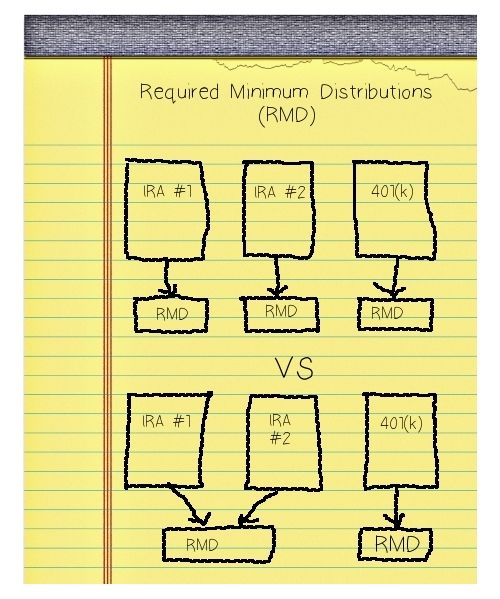Required Minimum Distributions
If you read USA Today, you might have read an article a while ago about Required Minimum Distributions ("Don't let IRS gobble your IRA with tax penalties," December 26, 2013). These are withdrawals from IRA accounts required by the tax code once a person reaches the age of 70-1/2, and every year thereafter. (NOTE: The SECURE Act of 2019 changed the age to 72) Unfortunately, if you did read the article, you were given some bad information (it has since been corrected in the online version of the article). The author first states that the initial withdrawal rate starts at 5%, when in fact it's closer to 4% -- not a big mistake, but he then uses the wrong IRS table to calculate his example RMD, overstating it by over $10,000 from a $500,000 IRA account.
Besides being another example of bad information in the media, the article also serves to emphasize the fact that you really need to consult with your financial advisor (hint: Marc, Matt, or Paul) when you find yourself in the RMD phase of your investments. There is so much more to consider when complying with the IRS RMD regulations that are not even mentioned in the article:
-
Instead of withdrawing your RMD out of each IRA account, you can calculate your total RMD for all IRA accounts and make the withdrawal from only one account. Depending on the type of account (annuity, regular IRA or 401(k)) or the investments in the account, this might be a better strategy for your particular situation. Note, however, that the total calculation must be for the SAME TYPE of IRA account. You cannot withdraw your RMD for your 401(k) from an IRA, or vice versa (see the diagram above). Also, you cannot combine 401(k) account RMDs, nor can you combine a regular IRA with an inherited IRA, although, if you have multiple inherited IRAs FROM THE SAME PERSON, they can be combined.
-
In some cases, the IRA custodian will calculate the RMD for your account value and send you a check or automatic deposit for that amount. However, if you're implementing a withdrawal-from-one-account strategy, you will need to contact that custodian to block that automatic withdrawal sometime before it occurs (usually in early December).
For more information on the rules regarding RMDs, you can read this article on our website, or call one of our financial advisors.


 Stout Bowman regularly posts important and interesting information on our blog. Current topics include credit/debit/loans, estate planning, insurance, investing, Medicare, retirement, Social Security and taxes, as well as general information that we think you might find of interest.
Stout Bowman regularly posts important and interesting information on our blog. Current topics include credit/debit/loans, estate planning, insurance, investing, Medicare, retirement, Social Security and taxes, as well as general information that we think you might find of interest.  We have been publishing an email newsletter for our clients and friends since 2016. Links to all of the newsletters can be found on our newsletter page, with the most recent listed first. We try to keep our emails short, so there are typically only three articles in each one, most of which link to other articles in the financial and mainstream press.
We have been publishing an email newsletter for our clients and friends since 2016. Links to all of the newsletters can be found on our newsletter page, with the most recent listed first. We try to keep our emails short, so there are typically only three articles in each one, most of which link to other articles in the financial and mainstream press.  We also have a page on our site for the latest news about our company, notice of any upcoming events, and a market commentary to discuss what our advisors and other financial industry experts conclude about the previous investment performance and what we might expect the markets and the economy will do in the coming months.
We also have a page on our site for the latest news about our company, notice of any upcoming events, and a market commentary to discuss what our advisors and other financial industry experts conclude about the previous investment performance and what we might expect the markets and the economy will do in the coming months.  Many news organizations offer what is called a Rich Site Summary (RSS) feed, a listing of the latest changes to their site's content. We have subscribed to several of these news feeds and present a list of their latest ten articles on a page on this website to save our clients the hassle of going to multiple websites just to see what is available. Currently, we subscribe to
Many news organizations offer what is called a Rich Site Summary (RSS) feed, a listing of the latest changes to their site's content. We have subscribed to several of these news feeds and present a list of their latest ten articles on a page on this website to save our clients the hassle of going to multiple websites just to see what is available. Currently, we subscribe to  At Stout Bowman every investment client is first a financial planning client; it's important to go through that process before we make any professional investment recommendations. Therefore, we strive to make financial planning understandable and comfortable every step of the way. One way to do that is to provide our clients access to financial education resources. To that end, we have subscribed to educational websites to receive their news feeds and present a list of their latest ten articles on a page on this website. Currently, we offer
At Stout Bowman every investment client is first a financial planning client; it's important to go through that process before we make any professional investment recommendations. Therefore, we strive to make financial planning understandable and comfortable every step of the way. One way to do that is to provide our clients access to financial education resources. To that end, we have subscribed to educational websites to receive their news feeds and present a list of their latest ten articles on a page on this website. Currently, we offer